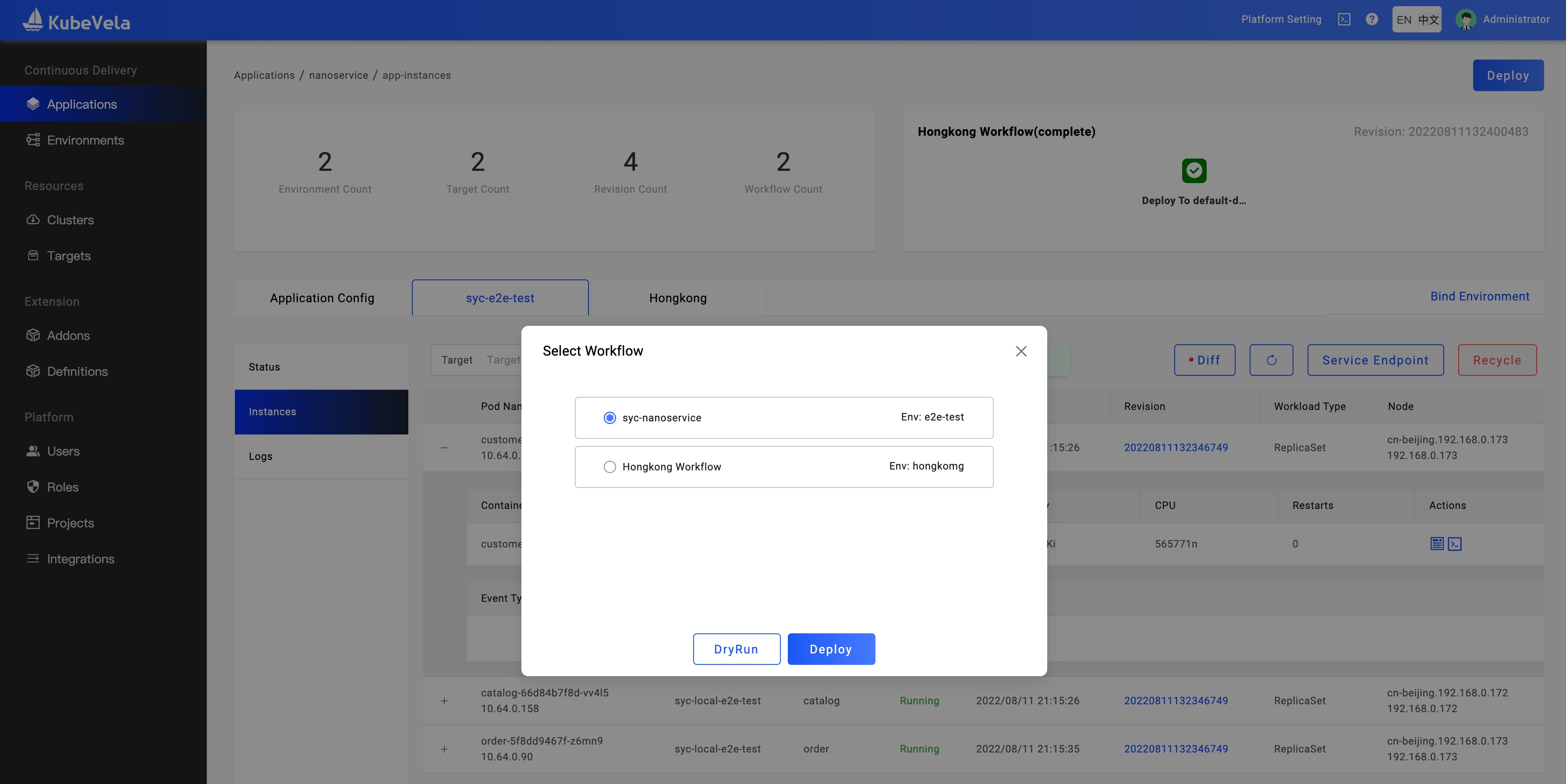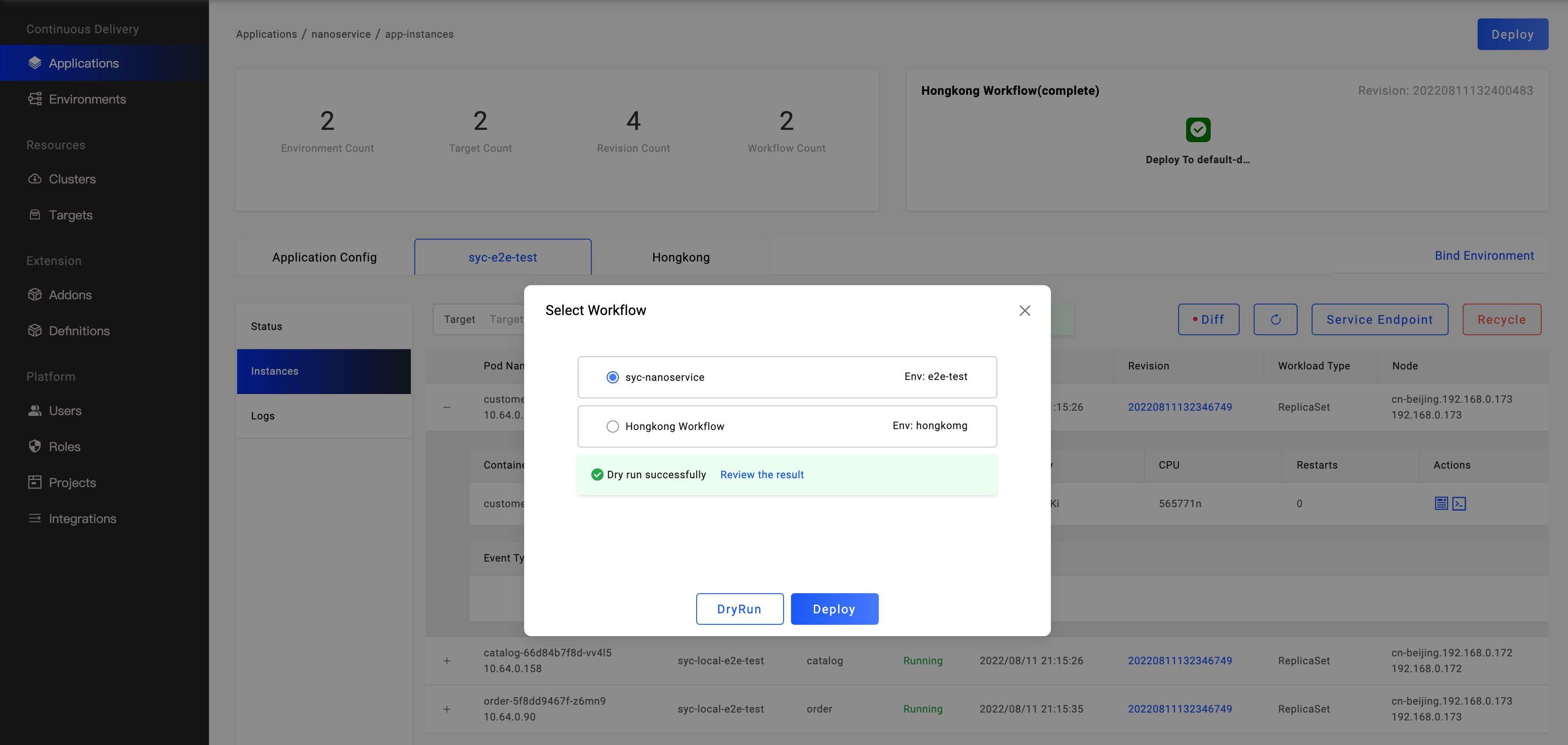Dry Run
The dry run feature is a very useful way to check the correctness of the application configuration and definitions. It will render the application and print the output resources that checked on the service side. If the definitions(component, trait) is invalid, the dry run will print the error message.
When you do the following things, you'd better use dry-run.
- Create or update an application.
- Create or update the definition, and dry run some example applications.
Dry run via CLI
There is a simple application:
kind: Application
apiVersion: core.oam.dev/v1beta1
metadata:
name: webservice-app
spec:
components:
- name: frontend
type: webservice
properties:
image: oamdev/testapp:v1
cmd: ["node", "server.js"]
ports:
- port: 8080
expose: true
traits:
- type: scaler
properties:
replicas: 1
Copy it and write a file app.yaml, execute the following command, and then the resources will be printed.
vela dry-run app.yaml
expected output
---
# Application(webservice-app) -- Component(frontend)
---
apiVersion: apps/v1
kind: Deployment
metadata:
annotations: {}
labels:
app.oam.dev/appRevision: ""
app.oam.dev/component: frontend
app.oam.dev/name: webservice-app
app.oam.dev/namespace: default
app.oam.dev/resourceType: WORKLOAD
workload.oam.dev/type: webservice
name: frontend
namespace: default
spec:
replicas: 1
selector:
matchLabels:
app.oam.dev/component: frontend
template:
metadata:
labels:
app.oam.dev/component: frontend
app.oam.dev/name: webservice-app
spec:
containers:
- command:
- node
- server.js
image: oamdev/testapp:v1
name: frontend
ports:
- containerPort: 8080
name: port-8080
protocol: TCP
---
## From the auxiliary workload
apiVersion: v1
kind: Service
metadata:
annotations: {}
labels:
app.oam.dev/appRevision: ""
app.oam.dev/component: frontend
app.oam.dev/name: webservice-app
app.oam.dev/namespace: default
app.oam.dev/resourceType: TRAIT
trait.oam.dev/resource: webserviceExpose
trait.oam.dev/type: AuxiliaryWorkload
name: frontend
namespace: default
spec:
ports:
- name: port-8080
port: 8080
targetPort: 8080
selector:
app.oam.dev/component: frontend
type: ClusterIP
---
If we set the expose field of the port as false, the output resources do not include the Service. If we set the replicas field as "1", the output will be an error message:
Error: validate application: ./app.yaml by dry-run: admission webhook "validating.core.oam.dev.v1beta1.applications" denied the request: field "schematic": Invalid value error encountered, cannot evaluate trait "scaler": invalid template of trait scaler after merge with parameter and context: parameter.replicas: conflicting values (*1 | int) and "1" (mismatched types int and string) (and 1 more errors).
This means the replicas field is int type but we provide a string value, this application configuration is not valid.
Dry run with policy and workflow via CLI
Override/topology Policies and deploy workflow are supported in v1.7.0+ now. While there're still some limitation that dry-run with policy and workflow will only take override, topology policies and deploy workflow step into considerations. Other workflow steps will be ignored.
Let's take the following application as example, the application explicitly specify override, topology policies and deploy workflow step.
apiVersion: core.oam.dev/v1beta1
kind: Application
metadata:
name: first-vela-app
spec:
components:
- name: express-server
type: webservice
properties:
image: oamdev/hello-world
ports:
- port: 8000
expose: true
traits:
- type: scaler
properties:
replicas: 1
policies:
- name: target-default
type: topology
properties:
clusters: ["local"]
namespace: "default"
- name: target-prod
type: topology
properties:
clusters: ["local"]
namespace: "prod"
- name: deploy-ha
type: override
properties:
components:
- type: webservice
traits:
- type: scaler
properties:
replicas: 5
workflow:
steps:
- name: deploy2default
type: deploy
properties:
policies: ["target-default"]
- name: manual-approval
type: suspend
- name: deploy2prod
type: deploy
properties:
policies: ["target-prod", "deploy-ha"]
Dry run will produce rendered results for both deploy2default and deploy2prod deploy steps as below:
expected output
---
# Application(first-vela-app with topology target-default) -- Component(express-server)
---
apiVersion: apps/v1
kind: Deployment
metadata:
annotations: {}
labels:
app.oam.dev/appRevision: ""
app.oam.dev/component: express-server
app.oam.dev/name: first-vela-app
app.oam.dev/namespace: default
app.oam.dev/resourceType: WORKLOAD
workload.oam.dev/type: webservice
name: express-server
namespace: default
spec:
replicas: 1
selector:
matchLabels:
app.oam.dev/component: express-server
template:
metadata:
labels:
app.oam.dev/component: express-server
app.oam.dev/name: first-vela-app
spec:
containers:
- image: oamdev/hello-world
name: express-server
ports:
- containerPort: 8000
name: port-8000
protocol: TCP
---
## From the auxiliary workload
apiVersion: v1
kind: Service
metadata:
annotations: {}
labels:
app.oam.dev/appRevision: ""
app.oam.dev/component: express-server
app.oam.dev/name: first-vela-app
app.oam.dev/namespace: default
app.oam.dev/resourceType: TRAIT
trait.oam.dev/resource: webserviceExpose
trait.oam.dev/type: AuxiliaryWorkload
name: express-server
namespace: default
spec:
ports:
- name: port-8000
port: 8000
targetPort: 8000
selector:
app.oam.dev/component: express-server
type: ClusterIP
---
---
# Application(first-vela-app with topology target-prod) -- Component(express-server)
---
apiVersion: apps/v1
kind: Deployment
metadata:
annotations: {}
labels:
app.oam.dev/appRevision: ""
app.oam.dev/component: express-server
app.oam.dev/name: first-vela-app
app.oam.dev/namespace: default
app.oam.dev/resourceType: WORKLOAD
workload.oam.dev/type: webservice
name: express-server
namespace: default
spec:
replicas: 5
selector:
matchLabels:
app.oam.dev/component: express-server
template:
metadata:
labels:
app.oam.dev/component: express-server
app.oam.dev/name: first-vela-app
spec:
containers:
- image: oamdev/hello-world
name: express-server
ports:
- containerPort: 8000
name: port-8000
protocol: TCP
---
## From the auxiliary workload
apiVersion: v1
kind: Service
metadata:
annotations: {}
labels:
app.oam.dev/appRevision: ""
app.oam.dev/component: express-server
app.oam.dev/name: first-vela-app
app.oam.dev/namespace: default
app.oam.dev/resourceType: TRAIT
trait.oam.dev/resource: webserviceExpose
trait.oam.dev/type: AuxiliaryWorkload
name: express-server
namespace: default
spec:
ports:
- name: port-8000
port: 8000
targetPort: 8000
selector:
app.oam.dev/component: express-server
type: ClusterIP
---
Each deploy workflow step with topology policy will render individual result.
It can be a bit redundant for you as you may just need to dry run for one environment at a time. The, you can use the external workflow feature like below.
Firstly, define policy and workflow as below in individual files:
The
target-prod.yamlandha.yamlcorresponding to theproductionenvironment.# target-prod.yaml
apiVersion: core.oam.dev/v1alpha1
kind: Policy
metadata:
name: target-prod
type: topology
properties:
clusters: ["local"]
namespace: "prod"# ha.yaml
apiVersion: core.oam.dev/v1alpha1
kind: Policy
metadata:
name: ha
type: override
properties:
components:
- type: webservice
traits:
- type: scaler
properties:
replicas: 5The
prod-workflow.yamlcan glue them together.# prod-workflow.yaml
apiVersion: core.oam.dev/v1alpha1
kind: Workflow
metadata:
name: deploy-prod
steps:
- type: deploy
name: deploy-prod
properties:
policies: ["ha", "target-prod"]Then the application can reference the workflow as below.
apiVersion: core.oam.dev/v1beta1
kind: Application
metadata:
name: first-vela-app
spec:
components:
- name: express-server
type: webservice
properties:
image: oamdev/hello-world
ports:
- port: 8000
expose: true
traits:
- type: scaler
properties:
replicas: 1
workflow:
ref: deploy-prod
The dry run command can be:
vela dry-run -f app.yaml -f target-prod.yaml -f ha.yaml -f prod-workflow.yaml
Then, the dry-run results will only contain resources in the production environment.
expected output
---
# Application(first-vela-app with topology target-prod) -- Component(express-server)
---
apiVersion: apps/v1
kind: Deployment
metadata:
annotations: {}
labels:
app.oam.dev/appRevision: ""
app.oam.dev/component: express-server
app.oam.dev/name: first-vela-app
app.oam.dev/namespace: default
app.oam.dev/resourceType: WORKLOAD
workload.oam.dev/type: webservice
name: express-server
namespace: default
spec:
replicas: 5
selector:
matchLabels:
app.oam.dev/component: express-server
template:
metadata:
labels:
app.oam.dev/component: express-server
app.oam.dev/name: first-vela-app
spec:
containers:
- image: oamdev/hello-world
name: express-server
ports:
- containerPort: 8000
name: port-8000
protocol: TCP
---
## From the auxiliary workload
apiVersion: v1
kind: Service
metadata:
annotations: {}
labels:
app.oam.dev/appRevision: ""
app.oam.dev/component: express-server
app.oam.dev/name: first-vela-app
app.oam.dev/namespace: default
app.oam.dev/resourceType: TRAIT
trait.oam.dev/resource: webserviceExpose
trait.oam.dev/type: AuxiliaryWorkload
name: express-server
namespace: default
spec:
ports:
- name: port-8000
port: 8000
targetPort: 8000
selector:
app.oam.dev/component: express-server
type: ClusterIP
---
Moreover, you can use --merge flag to merge external policies and workflow when application file is not reference to them.
For example, you can define the application as below, the only difference is there's no workflow field.
# app.yaml
apiVersion: core.oam.dev/v1beta1
kind: Application
metadata:
name: first-vela-app
spec:
components:
- name: express-server
type: webservice
properties:
image: oamdev/hello-world
ports:
- port: 8000
expose: true
traits:
- type: scaler
properties:
replicas: 1
the workflow and policy can be defined the same way
# workflow.yaml
apiVersion: core.oam.dev/v1alpha1
kind: Workflow
metadata:
name: deploy-demo
steps:
- type: deploy
name: deploy-prod
properties:
policies: ["target-prod"]
# target-prod.yaml
apiVersion: core.oam.dev/v1alpha1
kind: Policy
metadata:
name: target-prod
type: topology
properties:
clusters: ["local"]
namespace: "prod"
If you don't use --merge flag in this way, it will report warnings as below.
vela dry-run -f app.yaml -f target-prod.yaml -f workflow.yaml
result with warning messages
WARNING: workflow deploy-demo not referenced by application
WARNING: policy target-prod not referenced by application
---
# Application(default) -- Component(express-server)
---
apiVersion: apps/v1
kind: Deployment
metadata:
annotations: {}
labels:
app.oam.dev/appRevision: ""
app.oam.dev/component: express-server
app.oam.dev/name: first-vela-app
app.oam.dev/namespace: default
app.oam.dev/resourceType: WORKLOAD
workload.oam.dev/type: webservice
name: express-server
namespace: default
spec:
replicas: 1
selector:
matchLabels:
app.oam.dev/component: express-server
template:
metadata:
labels:
app.oam.dev/component: express-server
app.oam.dev/name: first-vela-app
spec:
containers:
- image: oamdev/hello-world
name: express-server
ports:
- containerPort: 8000
name: port-8000
protocol: TCP
---
## From the auxiliary workload
apiVersion: v1
kind: Service
metadata:
annotations: {}
labels:
app.oam.dev/appRevision: ""
app.oam.dev/component: express-server
app.oam.dev/name: first-vela-app
app.oam.dev/namespace: default
app.oam.dev/resourceType: TRAIT
trait.oam.dev/resource: webserviceExpose
trait.oam.dev/type: AuxiliaryWorkload
name: express-server
namespace: default
spec:
ports:
- name: port-8000
port: 8000
targetPort: 8000
selector:
app.oam.dev/component: express-server
type: ClusterIP
---
In this case, the policy and workflow do not take effect. Because those are not referenced by the application and being viewed as standalone files and ignored.
So to make those external files work, please provide "--merge" flag as below:
vela dry-run -f app.yaml -f target-prod.yaml -f workflow.yaml --merge
Then the application will be glued with external policies and workflows even no reference exists.
expected ouput
---
# Application(first-vela-app with topology target-prod) -- Component(express-server)
---
apiVersion: apps/v1
kind: Deployment
metadata:
annotations: {}
labels:
app.oam.dev/appRevision: ""
app.oam.dev/component: express-server
app.oam.dev/name: first-vela-app
app.oam.dev/namespace: default
app.oam.dev/resourceType: WORKLOAD
workload.oam.dev/type: webservice
name: express-server
namespace: default
spec:
replicas: 1
selector:
matchLabels:
app.oam.dev/component: express-server
template:
metadata:
labels:
app.oam.dev/component: express-server
app.oam.dev/name: first-vela-app
spec:
containers:
- image: oamdev/hello-world
name: express-server
ports:
- containerPort: 8000
name: port-8000
protocol: TCP
---
## From the auxiliary workload
apiVersion: v1
kind: Service
metadata:
annotations: {}
labels:
app.oam.dev/appRevision: ""
app.oam.dev/component: express-server
app.oam.dev/name: first-vela-app
app.oam.dev/namespace: default
app.oam.dev/resourceType: TRAIT
trait.oam.dev/resource: webserviceExpose
trait.oam.dev/type: AuxiliaryWorkload
name: express-server
namespace: default
spec:
ports:
- name: port-8000
port: 8000
targetPort: 8000
selector:
app.oam.dev/component: express-server
type: ClusterIP
---
You can refer to the Dry run command for more command line use cases.
Dry run via UI

Clicking the Deploy button to open the workflow selector dialog. You could select a workflow(every workflow corresponding to an environment) and click the DryRun button to execute a dry run. If passed, the result is like this

The result report is different from the CLI, there is a complete application configuration that is generated from the application metadata, you could check it. Different environments may have different application configurations.